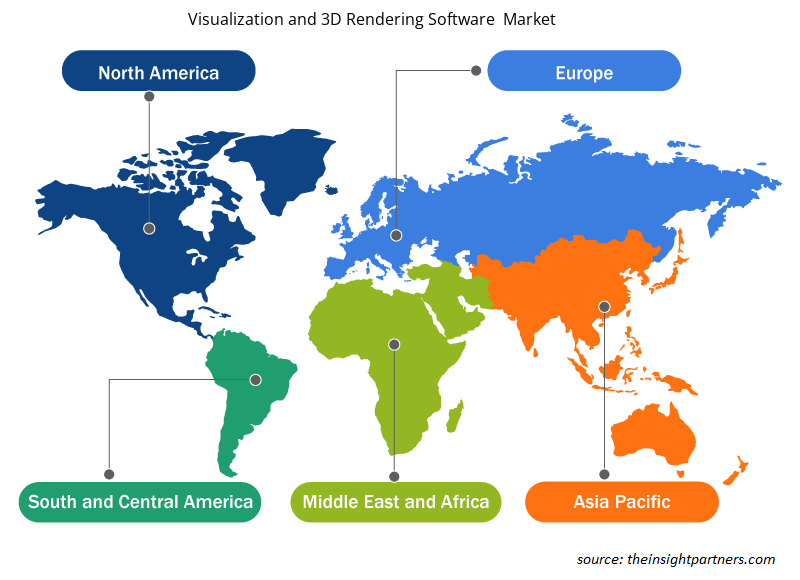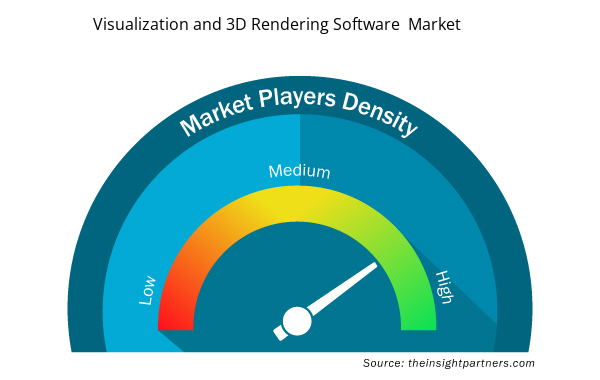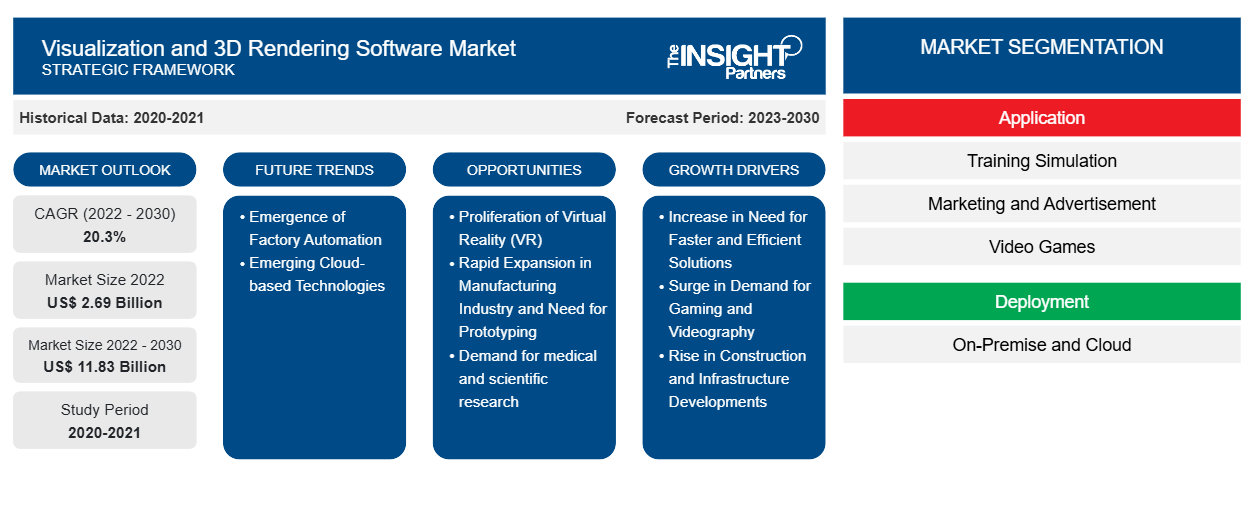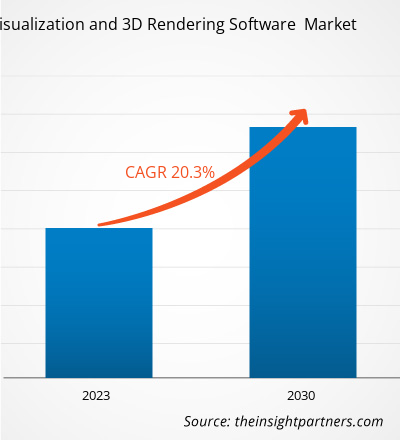[調査レポート] 可視化および 3D レンダリング ソフトウェア市場は、2022 年の 26 億 9,000 万米ドルから 2030 年までに 118 億 3,000 万米ドルに成長すると予想されています。可視化および 3D レンダリング ソフトウェア市場は、2022 年から 2030 年にかけて 20.3% の CAGR を記録すると予測されています。CAGR of 20.3% from 2022 to 2030.
視覚化および 3D レンダリング ソフトウェア市場アナリストの視点:
視覚化および 3D レンダリング ソフトウェア市場には、リアルな視覚表現が不可欠な幅広い業界とアプリケーションが含まれます。この市場は、技術の進歩、没入型体験の需要の増加、視覚コミュニケーションに依存する業界の拡大により、着実に成長しています。建築家、インテリア デザイナー、都市計画家は、3D レンダリング ソフトウェアを使用して、建物、インテリア、都市空間のリアルな視覚化を作成します。これにより、クライアントは設計コンセプトを理解し、情報に基づいた決定を下すことができます。たとえば、Autodesk の 3ds Max や Trimble の SketchUp などのソフトウェアは、建築の視覚化で広く使用されています。映画、アニメーション、ゲーム業界では、魅力的なビジュアルを作成するために 3D レンダリング ソフトウェアに大きく依存しています。例としては、映画のレンダリング用の Pixar の RenderMan、リアルタイム ゲーム グラフィックス用の Epic Games の Unreal Engine などがあります。また、不動産業者は 3D レンダリング ソフトウェアを使用して仮想物件ツアーを作成し、潜在的な購入者が遠隔地から物件を探索できるようにしています。Matterport は、3D 物件ツアーを作成するための人気のプラットフォームです。
3Dアニメーションの需要の増加、ARとVRの技術的進歩、3Dコンテンツの需要の増加、3Dディスプレイデバイスの成長は、世界の視覚化および3Dレンダリングソフトウェア市場を牽引しています。さらに、3Dコンテンツの精度を高めるために、視覚化および3Dレンダリングソフトウェアにおける人工知能や機械学習などの技術の採用と統合の増加が市場の成長を補完しています。これらすべての要因は、予測期間中に市場プレーヤーに十分な成長機会を提供すると予想されます。
視覚化および 3D レンダリング ソフトウェア市場の概要:
視覚化および 3D レンダリング ソフトウェア ツールは、ユーザーがオブジェクトの基本的な 3 次元モデルを設計するのに役立ちます。3D レンダリング テクノロジは、製品設計、リアルタイム マーケティング、トレーニング、およびその他のさまざまな機能に役立ちます。世界中の企業や個人ユーザーは、視覚化および 3D レンダリング ソフトウェア ツールを使用して、問題のある領域や改善が必要な側面を特定することで、運用を改善し、生産性を高め、リソースの使用を最適化しています。これらのツールは、エンジニアリングおよび建設、製造、輸送および物流などの土地中心の業界、およびメディアおよびエンターテイメント、ヘルスケア、教育などの他の業界で広く採用されています。
要件に合わせてレポートをカスタマイズする
このレポートの一部、国レベルの分析、Excelデータパックなど、あらゆるレポートを無料でカスタマイズできます。また、スタートアップや大学向けのお得なオファーや割引もご利用いただけます。
- このレポートの主要な市場動向を入手してください。この無料サンプルには、市場動向から見積もりや予測に至るまでのデータ分析が含まれます。
視覚化および 3D レンダリング ソフトウェア市場の推進要因:
より高速で効率的なソリューションに対するニーズの高まりが、可視化および 3D レンダリング ソフトウェア市場の成長を促進
従来の 3D モデルの設計方法は時間がかかり、コストもかかるため、新しい製品を導入しようとする企業にとって、視覚化とシミュレーションが中核的な要素となっています。
3D レンダリング ツールは、さまざまな業界で広く採用されています。ユーザーは、これらを使用して、素早くリアルな画像を作成し、プロトタイプを設計し、何かを構築する前に空間を完全に視覚化して徹底的に理解することができます。また、企業が利用可能なスペースとリソースを最適化するのにも役立ちます。さらに、企業がエラーを事前に回避し、実際の製品を作成する前に優れた設計を確保するのに役立ちます。3D レンダリング ソフトウェアは、クライアントへのプレゼンテーションやその他の活動に利用可能なスペースをより適切に視覚化できるため、企業にとって効果的なマーケティング ツールとして機能します。
3D モデルは、2D や他のモデルよりも速く仮想サイトや構造物を作成し、多くのエラーを排除して時間を節約するのに役立ちます。エンジニアや建築家はプロジェクトの設計に費やす時間を減らし、他の視覚化や製品設計のタスクを完了する時間を増やすことができます。また、専門家は事前に問題を特定できるため、スケジュールの変更や予算の増加を回避できます。
現在、さまざまな業界や分野の要件に合わせて特別に設計された 3D 視覚化ソフトウェアが数多く市場に出回っています。これらのソフトウェアは企業の既存のワークフローに簡単に適合し、リアルタイムのインタラクションと最適化機能を備えた非常にリアルな表示を提供します。また、製品エンジニアリング プロセス全体の設計を強化し、意思決定能力を向上させるのにも役立ちます。
アニメーション開発と迅速な視覚化を可能にすることで、このソフトウェアはアニメーション、画像処理、グラフィック設計のプロセス全体を加速するのに役立ちます。さらに、追加のモデルの必要性を排除します。これらすべての要因が、視覚化および 3D レンダリング ソフトウェア市場を牽引しています。
レポートのセグメンテーションと範囲:
視覚化および 3D レンダリング ソフトウェア市場は、アプリケーション、展開、エンド ユーザー、および地域に基づいてセグメント化されています。アプリケーションに基づいて、視覚化および 3D レンダリング ソフトウェア市場は、トレーニング シミュレーション、マーケティングおよび広告、ビデオ ゲーム、製品の視覚化、および建築の視覚化に分類されます。展開に基づいて、視覚化および 3D レンダリング ソフトウェア市場は、オンプレミスとクラウドに分類されます。エンド ユーザーに基づいて、視覚化および 3D レンダリング ソフトウェア市場は、メディアとエンターテイメント、建築と建設、設計とエンジニアリング、ヘルスケア、およびその他に分類されます。地理に基づいて、視覚化および 3D レンダリング ソフトウェア市場は、北米、ヨーロッパ、アジア太平洋、中東およびアフリカ、および南米に分類されます。
セグメント分析:
展開に基づいて、視覚化および 3D レンダリング ソフトウェア市場は次のように分割されます。
- オンプレミス
- 雲
オンプレミスセグメントは、2022年に視覚化および3Dレンダリングソフトウェアの市場シェアを拡大し、2022年から2030年にかけて市場でより高いCAGRを記録すると予想されています。オンプレミス展開では、ハードウェアとソフトウェアが会社の敷地内にインストールされ、保守されます。オンプレミスソリューションは、製造方法や使用されているテクノロジーなど、すべてのビジネスプロセスと現在の内部システムを維持できるようにすることで組織に大きなメリットをもたらし、データセキュリティ標準を実装し、制限内に収められたプロセス全体を制御することもできます。したがって、これらの企業は、視覚化と3Dレンダリングを独自の監視下で実装および保守することを好みます。さらに、オンプレミス展開は、これらのシステムの保守に多額の資本を投資できる大規模で確立された企業によって主に採用されています。
地域分析:
視覚化および 3D レンダリング ソフトウェア市場は、北米、ヨーロッパ、アジア太平洋 (APAC)、中東およびアフリカ (MEA)、南米の 5 つの主要地域に大まかに分割されています。北米は、2022 年に視覚化および 3D レンダリング ソフトウェア市場で最大のシェアを占めました。この地域の市場成長は、政府の好ましい政策や新技術の採用に対する前向きな見通しなどの要因に起因しています。さらに、堅牢なデジタル インフラストラクチャと主要な市場プレーヤーの存在により、視覚化および 3D レンダリング ソフトウェア市場が北米で繁栄するための道が開かれました。さらに、この地域には世界最大のメディアおよびエンターテイメント セクターがあり、最新の設計およびアニメーション ツールを使用して強化されたグラフィック コンテンツを制作しています。大規模な設計および研究開発センターを含む、世界のフォーチュン 500 企業のほとんどがこの地域に存在しています。製造会社は、市場で競争力のある製品を提供するために、視覚化や 3D レンダリング ツールなどの設計ツールに多額の投資を行っています。さらに、広大な製造セクターの存在は、北米の物流業界を補完しています。物流業界では、リソースの最適化に重点を置き、倉庫施設を最大限に活用するために、視覚化や 3D レンダリング ツールなどの高度なテクノロジーに積極的に投資しています。
主要プレーヤー分析:
レポートで紹介されている主要な視覚化および 3D レンダリング ソフトウェア市場のプレーヤーは、Autodesk Inc、Christie Digital Systems Inc、Dassault Systemes SE、NVIDIA Corp、Chaos Group、Luxion Inc、OTOY Inc、Next Limit、Act-3D、および Thea Render by Altair です。
視覚化および 3D レンダリング ソフトウェア
可視化および 3D レンダリング ソフトウェア市場の地域別分析
予測期間を通じて可視化および 3D レンダリング ソフトウェア市場に影響を与える地域的な傾向と要因は、Insight Partners のアナリストによって徹底的に説明されています。このセクションでは、可視化および 3D レンダリング ソフトウェア市場のセグメントと、北米、ヨーロッパ、アジア太平洋、中東およびアフリカ、南米および中米の地域についても説明します。

- 視覚化および3Dレンダリングソフトウェア市場の地域別データを入手
可視化および3Dレンダリングソフトウェア市場レポートの範囲
| レポート属性 | 詳細 |
|---|---|
| 2022年の市場規模 | 26億9000万米ドル |
| 2030年までの市場規模 | 118.3億米ドル |
| 世界のCAGR(2022年 - 2030年) | 20.3% |
| 履歴データ | 2020-2021 |
| 予測期間 | 2023-2030 |
| 対象セグメント | アプリケーション別
|
| 対象地域と国 | 北米
|
| 市場リーダーと主要企業プロフィール |
|
可視化および 3D レンダリング ソフトウェア市場のプレーヤーの密度: ビジネス ダイナミクスへの影響を理解する
視覚化および 3D レンダリング ソフトウェア市場は、消費者の嗜好の変化、技術の進歩、製品の利点に対する認識の高まりなどの要因により、エンド ユーザーの需要が高まり、急速に成長しています。需要が高まるにつれて、企業は提供内容を拡大し、消費者のニーズを満たすために革新し、新たなトレンドを活用し、市場の成長をさらに促進しています。
市場プレーヤー密度とは、特定の市場または業界内で活動している企業または会社の分布を指します。これは、特定の市場スペースに、その市場規模または総市場価値に対してどれだけの競合相手 (市場プレーヤー) が存在するかを示します。
視覚化および 3D レンダリング ソフトウェア市場で事業を展開している主要企業は次のとおりです。
- オートデスク株式会社
- クリスティデジタルシステムズUSA株式会社
- ダッソー・システムズ
- NVIDIA コーポレーション
- カオスグループ
免責事項:上記の企業は、特定の順序でランク付けされていません。

- 視覚化および3Dレンダリングソフトウェア市場のトップキープレーヤーの概要を入手
最近の動向:
視覚化および 3D レンダリング ソフトウェア市場のプレーヤーは、無機および有機の戦略を積極的に採用しています。最近の主要な市場動向をいくつか以下に示します。
- 2022年、オートデスクは、大手映画製作会社が使用するデジタルデイリー用の強力なクラウドベースプラットフォームを開発するニュージーランドを拠点とするMoxionの買収を発表しました。
- 2022 年、ジャガー・ランドローバーと NVIDIA は、顧客体験にインテリジェンスを注入することで、モダン ラグジュアリーを再定義します。また、DRIVE IX ソフトウェア スタックを活用して、ドライバーと乗員の監視や高度な視覚化などの AI 機能を車内に提供します。
- 2022 年に Chaos と Enscape が合併し、TA アソシエイツと LEA パートナーの支援を受ける予定です。テクノロジーに重点を置いたプライベート エクイティ会社が、建築、エンジニアリング、建設向けのリアルタイム レンダリングおよび設計ワークフロー テクノロジーの大手開発会社である Enscape を合併します。
- 過去2年間の分析、基準年、CAGRによる予測(7年間)
- PEST分析とSWOT分析
- 市場規模価値/数量 - 世界、地域、国
- 業界と競争環境
- Excel データセット



Report Coverage
Revenue forecast, Company Analysis, Industry landscape, Growth factors, and Trends

Segment Covered
This text is related
to segments covered.

Regional Scope
North America, Europe, Asia Pacific, Middle East & Africa, South & Central America

Country Scope
This text is related
to country scope.
よくある質問
Emergence of animated movies and video clips, which is anticipated to play a significant role in the global visualization and 3D rendering software market in the coming years.
The incremental growth expected to be recorded for the global visualization and 3D rendering software market during the forecast period is US$ 9.13 billion.
The key players holding majority shares in the global visualization and 3D rendering software market are Autodesk Inc, Dassault Systemes SE, NVIDIA CORP, Chaos Group, and ADOBE INC.
Increase in Need for Faster and Efficient Solutions and Surge in Demand for Gaming and Videography are the major factors that propel the global visualization and 3D rendering software market.
The global visualization and 3D rendering software market is expected to reach US$ 11.82 billion by 2030.
The global visualization and 3D rendering software market was estimated to be US$ 2.69 billion in 2022 and is expected to grow at a CAGR of 20.3 % during the forecast period 2023 - 2030.
Trends and growth analysis reports related to Technology, Media and Telecommunications : READ MORE..
The List of Companies - Visualization and 3D Rendering Software Marke
- Autodesk Inc.
- Christie Digital Systems USA, Inc.
- Dassault Systemes
- NVIDIA CORPORATION
- Chaos Group
- Luxion Inc.
- OTOY Inc.
- Next Limit
- Act-3D. (LUMION)
- Thea Render by Altair
The Insight Partners performs research in 4 major stages: Data Collection & Secondary Research, Primary Research, Data Analysis and Data Triangulation & Final Review.
- Data Collection and Secondary Research:
As a market research and consulting firm operating from a decade, we have published and advised several client across the globe. First step for any study will start with an assessment of currently available data and insights from existing reports. Further, historical and current market information is collected from Investor Presentations, Annual Reports, SEC Filings, etc., and other information related to company’s performance and market positioning are gathered from Paid Databases (Factiva, Hoovers, and Reuters) and various other publications available in public domain.
Several associations trade associates, technical forums, institutes, societies and organization are accessed to gain technical as well as market related insights through their publications such as research papers, blogs and press releases related to the studies are referred to get cues about the market. Further, white papers, journals, magazines, and other news articles published in last 3 years are scrutinized and analyzed to understand the current market trends.
- Primary Research:
The primarily interview analysis comprise of data obtained from industry participants interview and answers to survey questions gathered by in-house primary team.
For primary research, interviews are conducted with industry experts/CEOs/Marketing Managers/VPs/Subject Matter Experts from both demand and supply side to get a 360-degree view of the market. The primary team conducts several interviews based on the complexity of the markets to understand the various market trends and dynamics which makes research more credible and precise.
A typical research interview fulfils the following functions:
- Provides first-hand information on the market size, market trends, growth trends, competitive landscape, and outlook
- Validates and strengthens in-house secondary research findings
- Develops the analysis team’s expertise and market understanding
Primary research involves email interactions and telephone interviews for each market, category, segment, and sub-segment across geographies. The participants who typically take part in such a process include, but are not limited to:
- Industry participants: VPs, business development managers, market intelligence managers and national sales managers
- Outside experts: Valuation experts, research analysts and key opinion leaders specializing in the electronics and semiconductor industry.
Below is the breakup of our primary respondents by company, designation, and region:

Once we receive the confirmation from primary research sources or primary respondents, we finalize the base year market estimation and forecast the data as per the macroeconomic and microeconomic factors assessed during data collection.
- Data Analysis:
Once data is validated through both secondary as well as primary respondents, we finalize the market estimations by hypothesis formulation and factor analysis at regional and country level.
- Macro-Economic Factor Analysis:
We analyse macroeconomic indicators such the gross domestic product (GDP), increase in the demand for goods and services across industries, technological advancement, regional economic growth, governmental policies, the influence of COVID-19, PEST analysis, and other aspects. This analysis aids in setting benchmarks for various nations/regions and approximating market splits. Additionally, the general trend of the aforementioned components aid in determining the market's development possibilities.
- Country Level Data:
Various factors that are especially aligned to the country are taken into account to determine the market size for a certain area and country, including the presence of vendors, such as headquarters and offices, the country's GDP, demand patterns, and industry growth. To comprehend the market dynamics for the nation, a number of growth variables, inhibitors, application areas, and current market trends are researched. The aforementioned elements aid in determining the country's overall market's growth potential.
- Company Profile:
The “Table of Contents” is formulated by listing and analyzing more than 25 - 30 companies operating in the market ecosystem across geographies. However, we profile only 10 companies as a standard practice in our syndicate reports. These 10 companies comprise leading, emerging, and regional players. Nonetheless, our analysis is not restricted to the 10 listed companies, we also analyze other companies present in the market to develop a holistic view and understand the prevailing trends. The “Company Profiles” section in the report covers key facts, business description, products & services, financial information, SWOT analysis, and key developments. The financial information presented is extracted from the annual reports and official documents of the publicly listed companies. Upon collecting the information for the sections of respective companies, we verify them via various primary sources and then compile the data in respective company profiles. The company level information helps us in deriving the base number as well as in forecasting the market size.
- Developing Base Number:
Aggregation of sales statistics (2020-2022) and macro-economic factor, and other secondary and primary research insights are utilized to arrive at base number and related market shares for 2022. The data gaps are identified in this step and relevant market data is analyzed, collected from paid primary interviews or databases. On finalizing the base year market size, forecasts are developed on the basis of macro-economic, industry and market growth factors and company level analysis.
- Data Triangulation and Final Review:
The market findings and base year market size calculations are validated from supply as well as demand side. Demand side validations are based on macro-economic factor analysis and benchmarks for respective regions and countries. In case of supply side validations, revenues of major companies are estimated (in case not available) based on industry benchmark, approximate number of employees, product portfolio, and primary interviews revenues are gathered. Further revenue from target product/service segment is assessed to avoid overshooting of market statistics. In case of heavy deviations between supply and demand side values, all thes steps are repeated to achieve synchronization.
We follow an iterative model, wherein we share our research findings with Subject Matter Experts (SME’s) and Key Opinion Leaders (KOLs) until consensus view of the market is not formulated – this model negates any drastic deviation in the opinions of experts. Only validated and universally acceptable research findings are quoted in our reports.
We have important check points that we use to validate our research findings – which we call – data triangulation, where we validate the information, we generate from secondary sources with primary interviews and then we re-validate with our internal data bases and Subject matter experts. This comprehensive model enables us to deliver high quality, reliable data in shortest possible time.


 このレポートの無料サンプルを入手する
このレポートの無料サンプルを入手する